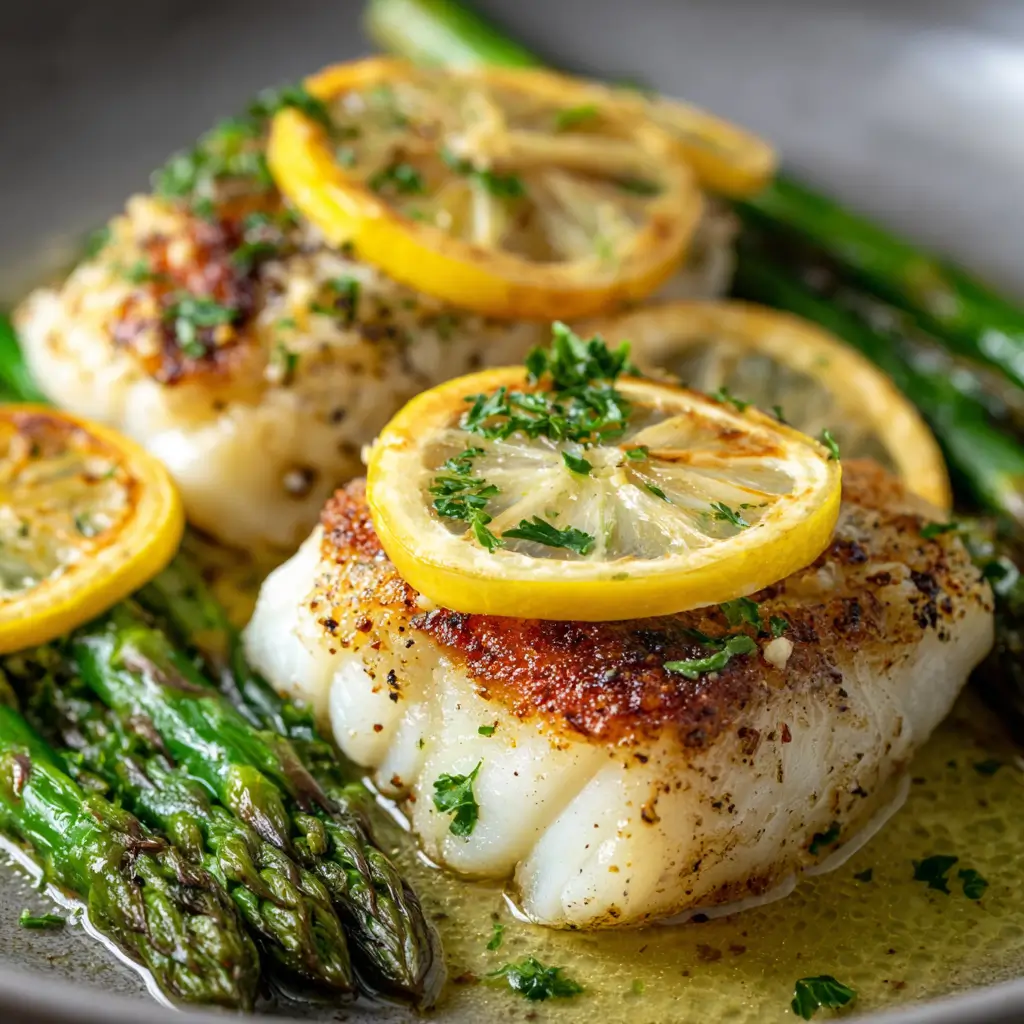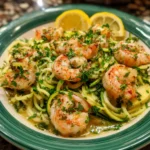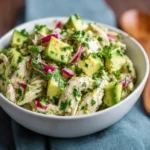Lemon Butter Cod: A Light, Flavorful Seafood Delight
When it comes to elegant yet simple seafood dishes, Lemon Butter Cod stands out as a culinary gem. This dish combines the delicate flakiness of cod with the bright tang of fresh lemon and the rich, velvety depth of butter, creating a harmonious balance that delights the palate. Whether you’re preparing a weeknight dinner or an impressive meal for guests, this recipe delivers restaurant-quality results with minimal effort. The subtle sweetness of the cod pairs perfectly with citrusy notes, while the butter adds a luxurious mouthfeel without overwhelming the fish’s natural flavor. In this comprehensive guide, we’ll explore every aspect of Lemon Butter Cod—from its historical roots and ingredient science to detailed cooking instructions, variations, health benefits, and frequently asked questions—so you can master this dish with confidence and flair.
The History of Lemon Butter Cod
While Lemon Butter Cod may seem like a modern fusion creation, its roots stretch back through centuries of European coastal cuisine. Cod has long been a staple in Northern European diets, especially in countries like Norway, Iceland, Portugal, and England, where salted and dried cod (bacalhau) has been preserved and consumed for generations. The use of butter and lemon in seafood preparation became popular during the 18th and 19th centuries, particularly in French and Italian coastal regions. French haute cuisine embraced the technique of beurre blanc—a warm emulsion of butter, vinegar, and shallots—which later evolved into simpler pan sauces using lemon juice instead of vinegar. As global trade expanded, fresh lemons became more accessible, making citrus a common companion to fish. American home cooks in the mid-20th century began combining these Old World techniques with local ingredients, leading to the rise of quick sautéed fish recipes featuring lemon and butter. Today, Lemon Butter Cod represents a delicious convergence of tradition, simplicity, and gourmet taste—a timeless dish that bridges cultures and eras on a single plate.
Ingredients Breakdown: Why Each One Matters
The magic of Lemon Butter Cod lies not just in its simplicity but in the careful selection and role of each ingredient. Let’s take a closer look at what goes into this dish and why each component is essential:
- Cod Fillets: Choose wild-caught or sustainably farmed Atlantic or Pacific cod. Its mild flavor, firm texture, and large flakes make it ideal for pan-searing. Cod absorbs flavors well without becoming overpowering, allowing the lemon and butter to shine.
- Unsalted Butter: Using unsalted butter gives you control over the dish’s salt content. High-quality European-style butter with a higher fat content (like Kerrygold or Plugrá) creates a silkier sauce and richer flavor.
- Fresh Lemon Juice and Zest: Freshly squeezed lemon juice provides acidity that cuts through the butter’s richness, while lemon zest adds aromatic oils that enhance the citrus profile without adding extra liquid.
- Garlic: Minced or thinly sliced garlic infuses the butter with savory depth. Be careful not to burn it, as bitter notes can overpower the delicate fish.
- Olive Oil: A neutral oil with a high smoke point, such as extra virgin olive oil or avocado oil, helps prevent the butter from burning during searing while adding a fruity undertone.
- Salt and Freshly Ground Black Pepper: Essential for seasoning. Salt enhances flavor and helps draw moisture from the fish surface for better browning; pepper adds warmth and complexity.
- Fresh Herbs (Parsley, Dill, or Thyme): Chopped parsley adds color and freshness, dill complements the fish with a slightly sweet-anise note, and thyme offers earthy warmth. These are typically added at the end for maximum aroma.
- White Wine (Optional): A splash of dry white wine (like Sauvignon Blanc or Pinot Grigio) deglazes the pan, lifting flavorful browned bits and enriching the sauce with subtle acidity and complexity.
- Flour (Optional for Coating): A light dusting of all-purpose flour helps create a golden crust and stabilizes the exterior of the fish, preventing it from falling apart during cooking.
Each ingredient plays a functional and sensory role, contributing to texture, flavor layering, and overall balance. Together, they elevate cod from a humble white fish to a gourmet centerpiece.
Step-by-Step Recipe: How to Make Perfect Lemon Butter Cod
Follow these detailed steps to achieve tender, flaky cod bathed in a luscious lemon butter sauce—ready in under 30 minutes.
- Prepare the Fish: Start with 4 skinless cod fillets (about 6 oz each), patted completely dry with paper towels. Moisture is the enemy of good searing, so thorough drying ensures a beautiful golden crust. Season both sides generously with kosher salt and freshly ground black pepper. For extra crispness, lightly dust both sides with all-purpose flour, shaking off any excess.
- Heat the Pan: Place a large non-stick or stainless steel skillet over medium-high heat. Add 1 tablespoon of olive oil and allow it to shimmer—this indicates the pan is hot enough for proper searing. Avoid overcrowding the pan; cook in batches if necessary.
- Sear the Cod: Carefully place the cod fillets in the hot pan, laying them away from you to prevent oil splatter. Sear undisturbed for 4–5 minutes until the bottom develops a golden-brown crust. Gently flip using a spatula and cook for another 3–4 minutes on the second side, depending on thickness. The internal temperature should reach 145°F (63°C), and the flesh should flake easily with a fork. Transfer to a plate and cover loosely with foil to rest.
- Make the Lemon Butter Sauce: Reduce the heat to medium-low. In the same pan (to capture the flavorful fond), add 1 minced garlic clove and sauté for 30 seconds until fragrant—do not let it brown. If using wine, pour in ¼ cup and simmer for 1–2 minutes until reduced by half. This step concentrates flavor and removes raw alcohol taste.
- Incorporate Butter and Lemon: Lower the heat to low. Gradually whisk in 4 tablespoons (½ stick) of cold unsalted butter, one piece at a time, allowing each to melt before adding the next. This slow emulsification creates a smooth, glossy sauce. Once all butter is incorporated, stir in 2 tablespoons of fresh lemon juice and 1 teaspoon of grated lemon zest.
- Finish with Herbs: Remove the pan from heat. Stir in 1–2 tablespoons of chopped fresh parsley or dill. Taste and adjust seasoning with additional salt, pepper, or lemon juice if needed.
- Serve Immediately: Spoon the warm lemon butter sauce generously over the cod fillets. Garnish with additional herbs and lemon slices for presentation. Serve hot alongside your favorite sides.
Tips for Success
- Dry the Fish Thoroughly: Wet fish steams instead of sears. Always pat cod dry before seasoning.
- Don’t Overcook: Cod turns rubbery when overcooked. It continues to cook slightly after removal from heat, so pull it off just before it looks fully done.
- Use Cold Butter: Adding cold butter gradually prevents the sauce from breaking (separating). Whisk constantly for a stable emulsion.
- Avoid High Heat When Making Sauce: High temperatures cause butter to separate. Keep the flame low and gentle.
- Rest the Fish: Allowing the cod to rest briefly keeps juices intact and improves texture.
- Skillet Choice Matters: Stainless steel pans give the best sear, while non-stick is forgiving for beginners. Cast iron works too but may impart color.
- Fresh Is Best: Use freshly squeezed lemon juice—not bottled—for superior brightness and flavor.
Variations and Customizations
Lemon Butter Cod is incredibly versatile. Try these creative twists to suit different tastes and dietary needs:
- Creamy Lemon Butter Sauce: Stir in 2–3 tablespoons of heavy cream or crème fraîche after the butter for a richer, silkier sauce.
- Spicy Kick: Add a pinch of red pepper flakes or a dash of cayenne when sautéing garlic for a subtle heat.
- Herb Variations: Swap parsley for tarragon (classic with fish), chives, or basil for a unique aromatic profile.
- Caprese Style: Top the finished dish with halved cherry tomatoes, fresh mozzarella pearls, and a drizzle of balsamic glaze.
- Mediterranean Twist: Add kalamata olives, sun-dried tomatoes, and capers to the sauce for a briny, bold flavor.
- Gluten-Free Option: Skip the flour coating or use rice flour or cornstarch for a crisp, gluten-free crust.
- Dairy-Free/Lighter Version: Replace butter with a blend of olive oil and vegan butter, or use a cashew cream base for a plant-based alternative.
- Baked Lemon Butter Cod: Arrange seasoned cod in a baking dish, pour over melted butter, lemon juice, and herbs, then bake at 375°F (190°C) for 15–20 minutes until flaky.
- Grilled Cod: Marinate cod in lemon juice, olive oil, garlic, and herbs for 30 minutes, then grill on a cedar plank or foil for smoky depth.
- Asian-Inspired Fusion: Use miso paste, ginger, soy sauce, and a touch of honey in place of some butter for a umami-rich twist.
Health Considerations and Nutritional Value
Lemon Butter Cod isn’t just delicious—it can also be part of a balanced, nutritious diet when prepared mindfully.
- High-Quality Protein: Cod is low in fat and high in lean protein, providing about 20–25 grams per 6-ounce serving. This supports muscle repair, satiety, and metabolic health.
- Rich in Omega-3 Fatty Acids: While not as high as fatty fish like salmon, cod still contains beneficial omega-3s, which support heart and brain health.
- Low in Calories: A typical serving of Lemon Butter Cod (without excessive butter) ranges from 250–350 calories, making it suitable for calorie-conscious diets.
- Vitamins and Minerals: Cod is a good source of vitamin B12 (essential for nerve function), phosphorus (for bone health), selenium (an antioxidant), and iodine (critical for thyroid function).
- Lemon Benefits: Lemon juice provides vitamin C, which boosts immunity, aids iron absorption, and acts as an antioxidant.
- Butter in Moderation: Butter contributes saturated fat and calories. To reduce fat, use half butter and half olive oil, or opt for grass-fed butter for higher nutrient density.
- Sodium Awareness: Control sodium levels by using unsalted butter and limiting added salt, especially important for those managing blood pressure.
- Heart-Healthy Swaps: For cardiovascular wellness, consider replacing half the butter with avocado oil or incorporating heart-healthy sides like quinoa, roasted vegetables, or a leafy green salad.
This dish fits well into Mediterranean, pescatarian, and flexitarian eating patterns, offering a nutritious way to enjoy seafood regularly.
Full Ingredients List
- 4 skinless cod fillets (about 6 oz each)
- Kosher salt, to taste
- Freshly ground black pepper, to taste
- 1 tablespoon olive oil (or avocado oil)
- 1–2 cloves garlic, minced
- 4 tablespoons (½ stick) unsalted butter, cold and cubed
- 2 tablespoons fresh lemon juice (about 1 lemon)
- 1 teaspoon lemon zest
- ¼ cup dry white wine (optional)
- 2 tablespoons fresh parsley or dill, chopped
- All-purpose flour (optional, for dredging)
- Lemon slices and extra herbs for garnish
Detailed Directions
- Pat cod fillets dry with paper towels. Season both sides with salt and pepper. Lightly coat with flour if desired, shaking off excess.
- Heat olive oil in a large skillet over medium-high heat until shimmering.
- Add cod fillets, being careful not to crowd the pan. Sear for 4–5 minutes per side until golden and cooked through. Transfer to a plate and cover with foil.
- Reduce heat to medium. Add garlic to the same pan and sauté for 30 seconds until fragrant.
- If using wine, pour it in and simmer for 1–2 minutes until reduced by half.
- Lower heat to low. Whisk in cold butter, one cube at a time, until fully melted and sauce is smooth.
- Stir in lemon juice, lemon zest, and fresh herbs. Remove from heat.
- Taste and adjust seasoning with salt, pepper, or additional lemon.
- Return cod to the pan briefly to rewarm, or spoon sauce generously over each fillet on serving plates.
- Garnish with lemon slices and fresh herbs. Serve immediately.
Frequently Asked Questions (FAQ)
Can I use frozen cod?
Yes, but thaw it properly in the refrigerator overnight. Never cook frozen cod directly, as it releases too much water and won’t sear properly.
What can I serve with Lemon Butter Cod?
Excellent pairings include roasted asparagus, garlic mashed potatoes, wild rice pilaf, quinoa, sautéed spinach, or a crisp arugula salad with lemon vinaigrette.
Can I make this ahead of time?
It’s best served fresh, but you can prep ingredients in advance. Store seasoned cod in the fridge and make the sauce just before serving.
Why did my sauce break?
Sauce breaks when butter is added too quickly or the heat is too high. To fix it, remove from heat, let cool slightly, and whisk in 1–2 teaspoons of cold water or cream to re-emulsify.
Is cod sustainable?
Look for MSC-certified (Marine Stewardship Council) cod or Alaskan cod, which are generally considered sustainable choices. Avoid Atlantic cod from overfished regions.
Can I use other fish?
Yes! This method works well with halibut, haddock, sea bass, or tilapia. Adjust cooking time based on thickness and flakiness.
How do I store leftovers?
Store in an airtight container in the refrigerator for up to 2 days. Reheat gently in a skillet over low heat to prevent drying out.
Can I freeze Lemon Butter Cod?
Freezing is not recommended, as the texture of cooked cod becomes mushy upon thawing. Freeze raw cod instead.
Summary
Lemon Butter Cod is a simple yet sophisticated dish that highlights the natural elegance of fresh seafood with vibrant citrus and rich butter. Quick to prepare and endlessly customizable, it’s a healthy, satisfying meal perfect for any occasion.










